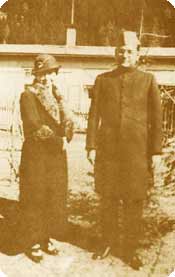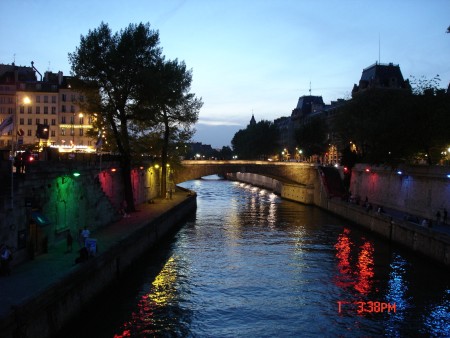So why Paris, why
now? Well, there is a long-ish story there, having to do with in-laws in Bombay, which I will spare you because it ended up being irrelevant to the trip. Suffice it to say, a six day trip to Paris near the end of a grueling academic semester wasn't my
choice, but once it was decided I happily went along. And had a lovely time.
Indeed, it's shocking that this was my first trip; from a literary and linguistic perspective I should have gone when I was 19, and studying both the French language and modernist literature in college. I remember being often embarrassed in graduate school that I had travelled so little outside of visiting India (and at that time I hadn't even seen very much of India).
Were we there to make a statement? No. We certainly got some looks, but then I get some looks even here in New Jersey. We did nothing political while we were there, and didn't really talk politics with anyone. We just went around and looked at Paris. That might be political in the very small sense that many of the South Asians one sees in Paris are very recent immigrants, who don't speak any French, and who are primarily in service positions. We are not that.
My favorite thing about Paris had to be the sidewalks, and the ubiquitous outdoor cafes, brasseries, restaurants, and bars. This is a relatively uncommon thing in New York, and even in San Francisco -- where the weather is generally nice but just a little on the nippy side in the evenings. The wide,
Georges Haussmann sidewalks are no doubt what enables it all.
* * * * *
Van GoghAfter a slightly groggy first day, we went to Auvers Sur Oise, where Vincent Van Gogh did paintings like
this. (Or try
these.) It's also the place where he committed suicide, and where both he and his brother Theo are buried.
From reading several of
Vincent's letters to Theo from this period, one gets the strong sense that he didn't love Auvers the way he loved Arles (specifically the colors of Arles -- and color was everything to Van Gogh). Still, it seems like the painter was in relatively good spirits at this spot. He did nearly a painting a day while he was there:
But anyway I am living one day at a time, the weather is so beautiful. And Iam well. I go to bed at nine o'clock, but get up at five most of the time. I hope that it will not be unpleasant to meet oneself again after a long absence. And I also hope that this feeling I have of being more master of my brush than before I went to Arles will last. And M. Gachet [Van Gogh's doctor and host] says that he thinks it most improbable that it will return, and that things are going on quite well.
The weather was superlative for our visit too, though I must say that all of the beautiful paintings Van Gogh did during his stay in Auvers are somewhat tainted by the fact that, after two months there, he suddenly committed suicide.
Because of that terrible act, going to this site is going into a mystery. On the surface there is all sun and the rustic pleasures of fields, a small town, and quiet. Underneath, for Van Gogh at least, there was something much darker. You can walk by the places where Van Gogh did his paintings:
this church,
this former corn-field. And you can only imagine, and dread, the emotional and psychological turbulence that once stood where you now stand.
I find Van Gogh's letters to be indispensible to understanding what was happening in his paintings. Both he and Theo were very smart and trusting letter writers.
* * * * *
The Louvre. What to say about the Louvre? A dreary day, but a necessary visit. My favorite Louvre photo is not one I took. It's by a Flickr member named "Funkyj," and it's
here.
You nailed it, Funkyj.
* * * * *
Nightlife, and PochoirtistesAt night, we wandered around Paris. We spent the most time in the area north of Place de la Bastille, along Rue de la Rocquette, and in Le Marais, where we had two very good dinners (one from a cheapo falafel place, one at a fancy-ish restaurant). We also spent an evening in the Latin Quarter, where we watched buskers and then a dixieland jazz trio at a wine bar. It was all very convivial and not too crowded. We never had to make a reservation for dinner, and we never met a rude waiter.
On one stroll through Le Marais, we came across a graffiti artist who was rapidly spray painting rather beautiful figures onto open spaces in a rather narrow lane off Rue Saint Antoine. A small band of groupies stood nearby, taking pictures, and gabbing -- so we decided to tag along.
A man came out of a nearby restaurant and started arguing with the artist about whether he was allowed to do what he was doing. I couldn't make it all out, but when a middle-aged woman among the bystanders told the man, "C'est un artiste!" I pretty much figured it out. The man went back inside the restaurant.
Two minutes later, there were police cars in the lane. The artists disappeared, and the crowd scattered. S. and I just stood there, eating our falafel sandwiches.
I learned the name of the artist the next day, when I was randomly watching the French news in our hotel room, and there was a story on the controversial graffiti artist Jerome Mesnager and the installation project underway at the
Section Urbaine. Mesnager is part of a moment that calls itself tha
"Paris Pochoirtistes."There is also a great blog post on this installation
here.
Going to the Louvre: 10 Euros ($15 at the current exchange rate). Watching high-concept graffiti artists who are well-known in the Paris arts scene be chased by cops: priceless.
* * * * *
"Let Them Eat Extremely Overpriced Little Sandwiches, and Let Them Stand in Long Lines"We also went to Versailles. Unlike the Louvre, this was actually fun. We made sure to spend a good 45 minutes in the "Mus&?acute;e de Parlement" that is at Versailles, just to balance the extreme Monarchialist bent of the place. I now know more about the history of the French Republic than I think is strictly necessary.
And we saw
Marie Antoinette's actual toilet. Worth the price of admission. (Well, almost -- entry fees are pretty exorbitant.)
The rude irony about Versailles is that some of its most famous residents
had their heads chopped off.
* * * * *
Impressionists and PointillistsAlso fun was the Musée d'Orsay, which is an Impressionists' paradise. They had a nice exhibit on post-Impressionism, and I learned a few things I didn't know about the advances in optics underlying
Pointillism -- optical mixing, divisionism, and basic color theory.
And I didn't know that Seurat took a decidedly anti-Romantic, scientistic approach to his method (see these
lecture notes). I suppose I was sleeping during that day in art history class in college.
It's interesting, because this aspect of optics is exactly what enables our televisions to produce the illusion of color even today. If the Impressionists were reconceiving the meaning of painting in an era of photography, the Pointillists were pre-conceiving painting for the era of television.
* * * * *
Don't mess with young Irish writers who idolize YeatsI had a pleasant argument about Yeats with the Irish dude working the counter at
Shakespeare & Co. He seemed to think of Yeats as a "desperate optimist." I can't bring myself to agree. But then Yeats is rather complicated, isn't he? How to manage the Occultism, the Elitism (and bad politics generally), the brilliant poetry, and the long and tumultuous life? No simple formula contains it all.
It's actually a nice bookstore, in case you were wondering. Best of all: open late. They have prominent displays of
Sylvia Beach and the Lost Generation on display there, as well as, of course,
Ulysses. I was too embarrassed to buy the book on Beach; I'm buying it now on Amazon.
* * * * *
Chatting with artistsOn the last day we were in Paris, we stumbled into something called the Grand-Marché d'Art Contemporain, mainly because it was three blocks from our hotel. This is a huge open fair, where artists bring their works to display and sell.
The cool thing is, the artists are actually there, and you can talk to them. Unlike many Parisians, who get annoyed by people (like me) who speak bad French, or who just speak English, the artists seemed quite excited that we took an interest in their work. I told one guy, who was doing a very precise kind of photo-realist painting, that his work resembled Gerhard Richter's, and he was positively
beaming.
We fell in love with some of the work we saw, and were even tempted a couple of times to buy something, though buying original art is something one thinks of as a hobby for people who are a) rich, and b) actually grown up. We are far from (a), and still resisting (b).
I think my taste is moving away from the conceptual art that I was into in college, and towards a more technical kind of expressionist painting and sculpture. I find I really like a rather non-ideological kind of beauty in painting. Is that reactionary?
(The previous paragraph sounds pretentious. Forgive me; I'm still a little jet-lagged.)
We made friends with one painter who called herself CAB. And we're still thinking of calling up Katia Neboit-Croze to
buy this painting, though the money it costs (not so very much) would be much better spent on other things -- like paying our bills.
* * * * *
Parisian PaneerOur best meal in Paris was, ironically, at the Indo-Pak restaurant called
Le Zaiqa, right across from our hotel near the Gare de Lyon. We were a little tripped out to find something that looked and, yes, smelled of home (meaning, New Jersey, not India) in Paris that for the first four days we studiously avoided going there.
But we were glad we did. They were so happy to have Punjabi-speaking patrons that they treated us very lavishly, giving us free dessert, masala chai, and after-dinner brandy.
The interesting thing was their paneer -- it didn't taste like paneer at all. It was sweeter and much softer. Is it possible they're using some kind of French cheese instead? And is this commmon in the Indian restaurants in Paris? We didn't find out. Whatever the case may be, that was some of the best mattar paneer I've ever had.
* * * * *
French MulticulturalismOn the last night, also, I watched a televised debate about Multiculturalism in France on one of the French news channels.
It's odd, because my French isn't great, but I pretty much understood the whole thing, despite the fact that they were speaking very fast and about something quite technical and complex.
On the pro-multiculturalism side were
Tariq Ramadan (of course), an Afro-French novelist and scholar named
Calixthe Beyala, and a character named Olivier le Cour Grandmaisoon. On the anti-multicultural, "Republican" (in the French sense) side there were three people, but only one of them seemed to be making really coherent arguments, and that was
Alain Finkielkraut, who has written a book called
Au Nom de l'Autre: Reflections sur l'anti-semitism qui vient (In the Name of the Other: Reflections on the Anti-Semitism to Come).
Finkielkraut was the main intellectual "conservative" in the debate, which tells you something about the intellectual scene in France, especially given that his earlier book,
In the Name of Humanity (tranlated by Judith Friedlander, on Columbia University Press), made arguments with which many on the cultural left might be sympathetic.
Still, Finkielkraut arguments in favor of a kind of assimilationist Republican in this new book and in this debate are fluid and formidable, and at times Ramadan, Beyala, and Grandmaison had to move quickly to counter them. At other times, the guy just wouldn't shut up, and the moderator did rather a poor job of handling him. He talked a lot about human rights, citizenship, the rule of law, and the "foulard" of Islamism.
Here is an interesting summary and analysis (in English) of another of Finkielkraut's books,
An Imaginary Jew. Both this article and the synopsis of Finielkraut's
In the Name of Humanity suggest a person rather more liberal than the one I saw on television, who was extremely antagonistic to any expression of Arab/Muslim political solidarity in France. Perhaps in recent years he's taken a sharper turn to the right?
On the left, Tariq Ramadan was the clear leader, though he was much more reserved than Finkielkraut on the other side of the table. Beyala was sharp and well-spoken, though slightly off-topic in my view (she kept bringing up the slave trade, which seems irrelevant to race-relations issues in France today). Olivier Le Cour Grandmaison was closer to the mark in his
arguments on France's failure to really face up to the damage done during the colonial era in Algeria. I'll be curious to check out his book
Coloniser Exterminer if/when it is translated, though I suspect I will find it to be rather strong medicine.


